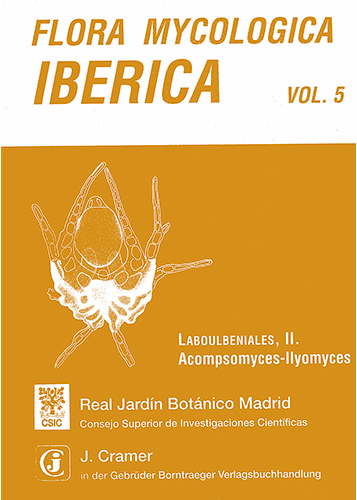Description
Description:
The volumes of Flora Mycologica Iberica describe and document the variety and nature of the fungi of the Iberian Peninsula. At the same time the volumes provide keys for the identification of the species treated.
As fungi differ considerably, their study requires a certain degree of specialization. On the other hand, some groups have received a greater degree of attention than others.
All volumes of Flora Mycologica Iberica are bilingual (english/spanish) and are profusely illustrated. They are edited by the Real Jardin Botanico, Madrid, the botanical Garden of Madrid, Spain.
The Laboulbeniales are a highly specialized and extremely diversified order of Ascomycetes on which already Thaxter (1896-1931) devoted five volumes of a beautifully illustrated monograph. After a number of further revisions by several authors, Santamaria has produced a local flora in 1989 and many distributed papers in the last 15 years. He is producing a 3-volumes monograph in the Flora Mycologica Iberica series, covering the Laboulbeniales of the Iberian peninsula. Volume 4 (part 1, 186 pp., 39 figs., 1998) had introduced the series, dealing only with the genus Laboulbenia. The remaining taxa are treated in alphabetical sequence and the present volume covers the genera Acampsomyces to Ilyomyces, part 3 will cover Misgomyces to Zodiomyces.
All texts are reproduced in Spanish and (good) English. The taxonomy has been checked by four leading experts of these fungi. The most modern insect taxonomy is followed with the support of numerous entomologists. The text is in the same arrangement as in vol. 4, without repetition of introductory chapters, but including a glossary of morphological terms with standard abbreviations as used in labelling the line drawings. The species are keyed out (also bilingually) for each genus. Mostly one plate (whole page or less) of beautiful line drawings is dedicated to each species. The book is concluded by references, indexes to host genera and species, and fungal names (according to epithet). A comprehensive key to the genera is expected in part 3.
Thus the Laboulbeniales are thoroughly explored in the Iberian peninsula, comparable to the situation in North America, France, Italy, Hungary, Belgium, Finland, Poland, Japan, and Korea, besides some other, less exhaustively inventoried countries. The taxonomic knowledge gained in this monograph will have its impact in a much broader area than the Iberian Peninsula.
W. GAMS, Utrecht
Nova Hedwigia vol. 79/3-4



Reviews
There are no reviews yet.